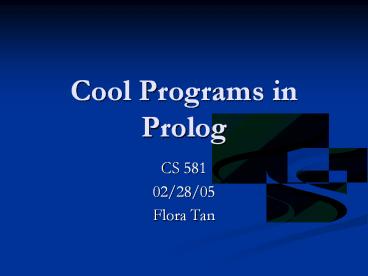Cool Programs in Prolog - PowerPoint PPT Presentation
Title:
Cool Programs in Prolog
Description:
Why is this cool? Graph search algorithms uses DFS/BFS and Adjacency List/Adjacency Matrix. ... Coding in C is about 300 lines because we have to implement our ... – PowerPoint PPT presentation
Number of Views:401
Avg rating:3.0/5.0
Title: Cool Programs in Prolog
1
Cool Programs in Prolog
- CS 581
- 02/28/05
- Flora Tan
2
A Graph Example
- A connected graph.
- Vertices 1, 2, 3, 4, 5.
- Edges are the
- connecting lines.
- Find all paths between
- any two vertices.
- Easy to implement in
- Prolog.
3
Prolog
- List the edges as facts.
- edge(1,2).
- edge(1,3).
- edge(1,4).
- edge(2,3).
- edge(2,5).
- edge(3,4).
- edge(3,5).
- edge(4,5).
4
Prolog
- Add the rules. Options
- The edges are bi-directional. We could list out
another eight edges as facts. - Ex edge(2,1), edge(3,1), edge(3,2), edge(4,1),
edge(4,3), edge(5,2), edge(5,3), edge(5,4) - Use disjunction.
- connected(X,Y) - edge(X,Y) edge(Y,X).
5
Prolog
- Add the rules. Options (continue)
- Alternatively, we could write this as two rules.
- connected(X,Y) - edge(X,Y).
- connected(X,Y) - edge(Y,X).
- But we dont want to do this. An infinite loop.
- edge(X,Y) - edge(Y,X).
6
Prolog
- The rest of the code.
- path(A,B,Path) -
- travel(A,B,A,Q),
- reverse(Q,Path).
- travel(A,B,P,BP) -
- connected(A,B).
- travel(A,B,Visited,Path) -
- connected(A,C),
- C \ B,
- not(member(C,Visited)),
- travel(C,B,CVisited,Path).
- Note the following
- Conjunction
- Goal matching
- Recursive search
- List processing reverse, member
- Accumulator
7
Prolog
- Base case
- travel(A,B,P,BP) -
- connected(A,B).
- Inductive case
- travel(A,B,Visited,Path) -
- connected(A,C),
- C \ B,
- not(member(C,Visited)),
- travel(C,B,CVisited,Path).
- A path from A to B is obtained if A and B are
connected. - A path from A to B is obtained provided that A is
connected to a vertex C different from B that is
not on the previously visited part of the path,
and one continues finding a path from C to B.
8
Running the program
- Load the program into SWI-Prolog
- ?- swi('demo/test').
- Run the program.
- ?- path(1,5,P).
- P 1, 2, 5
- P 1, 2, 3, 5
- P 1, 2, 3, 4, 5
- P 1, 4, 5
- P 1, 4, 3, 5
9
Continue
- The paths.
- P 1, 4, 3, 2, 5
- P 1, 3, 5
- P 1, 3, 4, 5
- P 1, 3, 2, 5
10
Why is this cool?
- Graph search algorithms uses DFS/BFS and
Adjacency List/Adjacency Matrix. - Prolog uses Depth First Search.
- Other graphs examples searching a maze,
Dijkstras algorithm, graph coloring. - Coding in C is about 300 lines because we have to
implement our own DFS and Adjacency List/Matrix.
11
Adjacency List / Matrix
- Adjacency List
- an array of pointers to linked lists
- 1 -gt 2 -gt 3 -gt 4
- 2 -gt 1 -gt 3 -gt 5
- 3 -gt 1 -gt 4 -gt 5
- 4 -gt 1 -gt 3 -gt 5
- 5 -gt 2 -gt 3 -gt 4
- Adjacency Matrix
- a 2D array of integers
- 1 2 3 4 5
- 1 0 1 1 1 0
- 2 1 0 1 0 1
- 3 1 0 0 1 1
- 4 1 0 1 0 1
- 5 0 1 1 1 0
12
References
- Programming in Prolog by W. F. Clocksin and C. S.
Mellish. - Prolog tutorial
- http//www.csupomona.edu/jrfisher/www/prolog_tuto
rial/2_15.html































